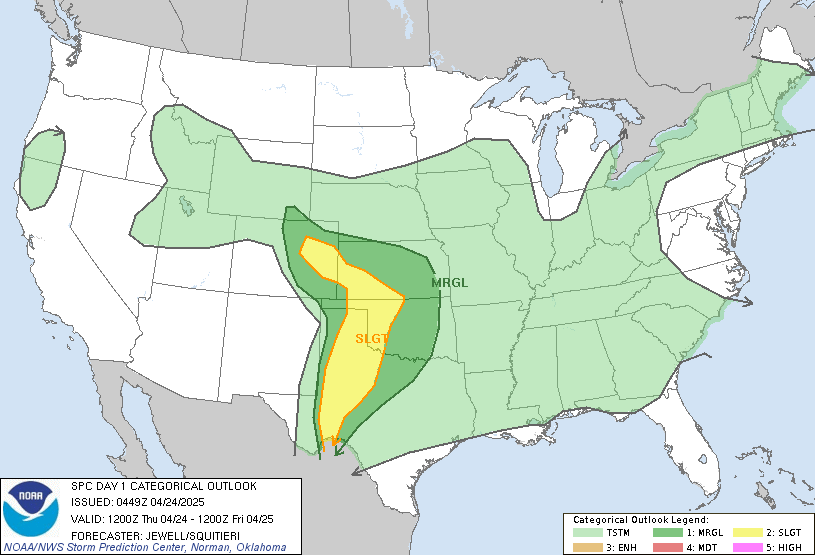LIVE MAP (ABOVE) ... SPC 1630Z Day 1 Outlook
Day 1 Convective Outlook
NWS Storm Prediction Center Norman OK
1123 AM CDT Tue Mar 18 2025
Valid 181630Z - 191200Z
...THERE IS A MARGINAL RISK OF SEVERE THUNDERSTORMS TONIGHT ACROSS
PARTS OF SOUTHEASTERN NEBRASKA THROUGH SOUTHWESTERN AND CENTRAL
IOWA...
...SUMMARY...
Isolated, marginally severe hail is possible by late tonight in a
corridor from north central Kansas through central Iowa.
...Discussion...
Much of the nation remains under the influence of one prominent belt
of westerlies emanating from the northern mid-latitude Pacific.
Within this regime, mid-level troughing is in the process of digging
across the Intermountain West and Rockies. This includes one
significant embedded smaller-scale perturbation approaching the
southern Rockies, which is forecast to accelerate east-northeastward
across the south central Great Plains by late tonight.
Models indicate that this will be accompanied by a strong mid/upper
jet streak, including a core intensifying in excess of 100 kt around
500 mb, nosing across the Texas Panhandle vicinity through the lower
Missouri Valley from early this evening through 12Z Wednesday. It
appears that this may be accompanied by substantive further
deepening of a developing low across central through northeastern
Kansas, within already deep surface troughing now present across the
central/southern Great Plains into lower/middle Missouri Valley.
In the wake of the prior cyclone which impacted much of the central
and eastern U.S. and Gulf Basin late last week into the weekend,
boundary-layer moistening across the western Gulf is underway, but
still only supportive of rather modest low-level moistening across
the Texas Gulf coast into southeastern Great Plains (including low
to mid 50s F surface dew points). It appears that this will reach
portions of the lower central Great Plains into Upper Midwest late
this evening through early Wednesday. However, relatively warm and
dry air in the lower/mid-troposphere, associated with a broad plume
of elevated mixed-layer air overspreading the central/southern Great
Plains and middle/lower Mississippi Valley, will tend to impede an
appreciable risk for thunderstorm development.
...Central Great Plains toward the Upper Midwest...
Perhaps as early as late this evening, into the overnight hours,
model output continues to indicate that strengthening mid/upper
forcing for ascent, coupled with better low-level moisture return,
will overcome the inhibition and support a corridor of thunderstorm
development. This likely will be focused within strengthening
lower/mid-tropospheric warm advection, along a frontal zone
extending to the east-northeast of the surface cyclone, across
southeastern Nebraska through central Iowa by late tonight.
Based at least on the latest NAM, it appears that the more sustained
and stronger thunderstorm development may initiate as early as late
evening near/east-northeast of the Concordia KS vicinity, before
spreading northeastward. This seems likely to occur as convection
begins to become increasingly rooted below the 700 mb level, closer
to 850 mb, with soundings perhaps becoming characterized by "loaded
gun" thermodynamic profiles above the near-surface stable layer.
Although most unstable CAPE may mostly peak in the 500-750 J/kg
range, stronger cells may become conducive to marginally severe
hail, aided by strong shear in the convective layer.
The potential for strong surface gusts is somewhat more uncertain.
Although the risk for strong downdrafts to reach the surface appears
negligible, gravity wave induced surface pressure perturbations
supportive of gusty winds may not be entirely out of the question.
..Kerr/Bunting.. 03/18/2025
Read more CHECK UPDATE ZOOM GRAPHIC
http://dlvr.it/TJc1WX
Windy.com Temps | Gusts | WU KORD KPWK |
CLICK for this month's BIG night sky ... | RADAR FULL MAP SCREEN |
|---|
MOBILE DEVICE? Turn sideways. Weather conditions directly above are near Lakefront. Top tabs refer to O'Hare (official).
Archives for the SPC Convective Outlook are updated daily (approximately) with a live map at the beginning of each article. Follow the link at the end of the article to check for current updates on the NOAA/NWS Storm Prediction Center website. Also, see Archives for Chicago's hourly weather data on CARDINAL NEWS Magazine.
CONVECTIVE | TORNADO | WIND | HAIL
O'Hare International Airport KORD
(Arlington Heights South)
Chicago Executive Airport KPWK
(Arlington Heights North)
Tuesday, March 18, 2025
SPC Mar 18, 2025 1630 UTC Day 1 Convective Outlook
SUNRISE AND SUNSET TIMES IN UTC (if you're not logged in to Google)
CHICAGO UTC-6 during CST (Central Standard Time, e.g., winter)
CHICAGO UTC-5 during CDT (Daylight Savings Time, e.g., summer)
CHICAGO UTC-6 during CST (Central Standard Time, e.g., winter)
CHICAGO UTC-5 during CDT (Daylight Savings Time, e.g., summer)





















